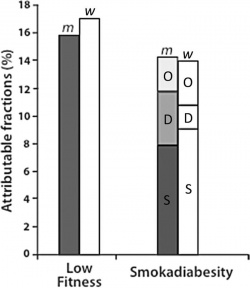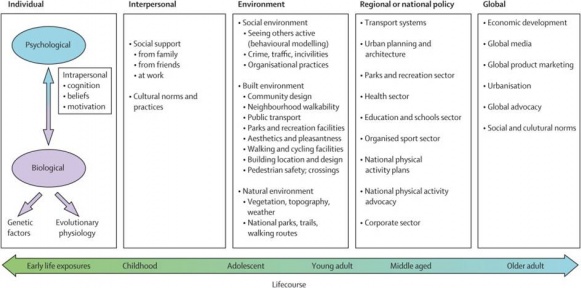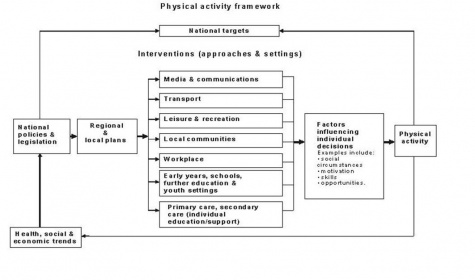Tackling Physical Inactivity: A Resource for Raising Awareness in Physiotherapists
Original Editors - Jason Chang, Andrea Christoforou, Maria Cuddihy, Christine Gorsek, Annika Höbler as part of the QMU Current and Emerging Roles in Physiotherapy Practice Project
INTRODUCTION TO WIKI RESOURCES[edit | edit source]
PHYSICAL INACTIVITY: THE PUBLIC HEALTH PROBLEM[edit | edit source]
Physical inactivity has been deemed the “biggest public health problem of the 21st century”[1] and has been shown to kill more people than smoking, diabetes and obesity combined[2] . It is ranked as the fourth leading risk factor for global mortality, killing approximately 3.2 million (~6% of the total deaths) people annually and accounting for approximately 32.1 million disability adjusted life years (DALYs; ~2.1% of global DALYs) annually[3].

|
Figure 1.[2] |
The major burden of disease attributed to physical inactivity is a result of its established role as one of the main risk factors for non-communicable diseases (NCDs), including cardiovascular disease, diabetes and cancer. In 2008, NCDs were responsible for 63% of the 57 million deaths worldwide[4] , with physical inactivity estimated to be directly responsible for 6% of the disease burden from coronary heart disease, 7% of type 2 diabetes and 10% of each of breast and colon cancers[5]. If physical inactivity were eliminated, this would translate to an estimated 5.3 million deaths being averted each year, or, more realistically, 533000 or 1.3 million with physical inactivity being reduced by 10% or 25%, respectively[5]. These figures do not include the increased risk of morbidity and mortality due to other factors, such as adiposity, raised blood glucose concentrations and high blood pressure, which are directly affected by physical inactivity[6].
A recent analysis of global data collected by the World Health Organization (WHO) estimated that 31.1% of adults (aged 15 years or older) worldwide are physically inactive[7]. For this analysis, physical inactivity was defined as not achieving the equivalent of 30 minutes of moderate-intensity activity at least 5 days per week or 20 minutes of vigorous-intensity activity at least 3 days per week[7]. Inactivity was found to increase with age and socio-economic status[7]. For adolescents aged 13 to 15 years old, the problem appears to be worse, with more than 80% reportedly not achieving the public health goal of 60 minutes of moderate to vigorous activity per day, and with girls being less active than boys[7]. Figure x below (Jason’s figure, adapted from BHF report) summarises the levels of inactivity, defined as not meeting the recommended national physical activity guidelines at that time, for the countries in the UK.
The factors contributing to this “physical inactivity pandemic” go beyond personal (e.g. as reported in BHF 2012 and/or Maz’s table; ref BHF 2012 – chpt 6). It is being recognised more and more that social, cultural, environmental and national and global policy level factors also play a substantial role, resulting in an ecological model of physical activity as illustrated in the Figure 3. (from Bauman et al 2012 Lancet – ecological model). Thus, interventions aimed at all levels are necessary for the problem to be properly addressed[8], as illustrated in the Physical Activity Framework proposed by NICE Figure 4. (ref. show http://publications.nice.org.uk/physical-activity-and-the-environment-ph8/public-health-need-and-practice#physical-activity-framework).
 |
| Figure 3. |

|
| Figure 4. |
To that end, leading the global forum, WHO has adopted the WHO global strategy on diet, physical activity and health (ref doc/site), publishing recommended physical activity guidelines (ref site) and providing implementation aids to support national policymakers[8]. In the UK, Start active, stay active: a report on physical activity from the four home countries' Chief Medical Officers[9] was recently (year?) published, providing updated national guidelines, the evidence for them and guidance for their local implementation. Thus, as physical activity is finally being recognised as a public health priority, all eyes on issue…(a concluding statement? something about it only recently being considered a public health priority (Kohl 2012) - here or at end of next section showing evidence for PA )
KEY DOCUMENT[edit | edit source]
The Lancet 2012;
CPD[edit | edit source]
(reflection?) Questionnaires used to collect this information are not without limitations and flaws...fraught with self-report bias (ref) and vary in reliability and validity in different age groups and clinical populations (ref; http://www.ijbnpa.org/content/9/1/103). Reflect on how these limitations may impact these analyses and affect interpretation.
PHYSICAL ACTIVITY: THE BEST MEDICINE[edit | edit source]
All parts of the body which have a function if used in moderation and exercised in labour in which each is accustomed, become thereby healthy, well developed and age more slowly; but if unused and left idle they become liable to disease, defective in growth and age quickly.
- Hippocrates, the Father of Medicine, ca 400 B.C.
PA Definition Box (Jason)
Evidence
In addition to the high prevalence and corresponding harmful health consequences of physical inactivity, physical activity has become a public health priority by virtue of the body of evidence supporting its effectiveness as a whole-body/holistic? health intervention (Kohl et al 2012 Lancet). While physical activity has only recently (ca 2000) factored into the public health agenda (Kohl et al 2012 Lancet), quantitative evidence of its widespread health benefits has been formally emerging since 1950s when Professor Morris and colleagues showed that men engaged in work requiring a level of physical activity (e.g. active conductor or postmen) were less likely to suffer from coronary heart disease than men with sedentary jobs (e.g. bus drivers or clerical workers) (Paffenbarger RS Jr, Blair SN, Lee IM. A history of physical activity, cardiovascular health and longevity: the scientific contributions of Jeremy N Morris, DSc, DPH, FRCP. Int J Epidemiol 2001;30(5):1184-92). Sixty years later, the evidence continues to materialize with a recent study suggesting that exercise can be as effective as drug interventions in the prevention and rehabilitation of number of health conditions (Naci and Ioannidis 2013).
The Youtube video by Dr. Mike Evans below creatively presents some of the most compelling evidence of the effectiveness of physical activity in maintaining health and well-being:
| [10] |
23 and 1/2 Hours: What is the single best thing we can do for our health? |
PHYSIOTHERAPISTS AS "PHYSICAL ACTIVITY CHAMPION"
[edit | edit source]
THE PHYSICAL ACTIVITY "VITAL SIGN"[edit | edit source]
MOBILISING BEHAVIOUR CHANGE[edit | edit source]
PHYSICAL ACTIVITY "ON PRESCRIPTION"[edit | edit source]
EXTENDED ROLES OF THE PHYSIOTHERAPIST[edit | edit source]
KEY RESOURCES[edit | edit source]
REFERENCES[edit | edit source]
- ↑ Blair SN. Physical inactivity: the biggest public health problem of the 21st century [warm up] .fckLRBr J Sports Med 2009;43(1):1-2.
- ↑ 2.0 2.1 Khan KM, Tunaiji HA. As different as Venus and Mars: time to distinguish efficacy (can it work?) from effectiveness (does it work?) [warm up] . Br J Sports Med 2011;45(10):759-760.
- ↑ Global Health Observatory (GHO).Prevalence of physical inactivity 2013; Available at: http://www.who.int/gho/ncd/risk_factors/physical_activity_text/en/index.html Accessed 20 November 2013.
- ↑ Global Health Observatory (GHO).Noncommunicable diseases (NCD) 2013; Available at: http://www.who.int/gho/ncd/en/index.html Accessed 20 November 2013.
- ↑ 5.0 5.1 Lee IM, Shiroma EJ, Lobelo F, Puska P, Blair SN, Katzmarzyk PT. Effect of physical inactivity on major non-communicable diseases worldwide: an analysis of burden of disease and life expectancy. Lancet 2012;380(9838):219-29.
- ↑ Hallal PC, Bauman AE, Heath GW, Kohl HW, Lee IM, Pratt M. Physical activity: more of the same is not enough [comment] . Lancet 2012;380(9838):190-1.
- ↑ 7.0 7.1 7.2 7.3 Hallal PC, Andersen LB, Bull FC, Guthold R, Haskell W, Ekelund U. Global physical activity levels: surveillance progress, pitfalls, and prospects. Lancet 2012;380(9838):247-57.
- ↑ 8.0 8.1 Kohl HW 3rd, Craig CL, Lambert EV, Inoue S, Alkandari JR, Leetongin G, Kahlmeier S The pandemic of physical inactivity: global action for public health. Lancet 2012;380(9838):294-305.
- ↑ Department of Health. Start active, stay active: a report on physical activity from the four home countries’ Chief Medical Officers 2011; Available at: https://www.gov.uk/government/publications/start-active-stay-active-a-report-on-physical-activity-from-the-four-home-countries-chief-medical-officers Accessed 20 November 2013.
- ↑ DocMikeEvans. 23 and 1/2 hours: What is the single best thing we can do for our health?. Available from: http://www.youtube.com/watch?v=aUaInS6HIGo [last accessed 18/11/13]
References will automatically be added here, see adding references tutorial.






